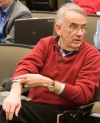Director's Corner
10 May 2007
DOE and NSF Review of the ILC-Americas Programme
Today's issue features a Director's Corner from Gerry Dugan, the outgoing GDE Americas Regional Director. Michael Harrison took over as the new GDE Americas Regional Director on 1 May.
The second review of the US R&D programme for the International Linear Collider (ILC) by the Department of Energy (DOE) and the National Science Foundation (NSF) was held at Fermilab from 30 April to 2 May 2007. This meeting served as DOE and NSF's primary peer review of the US portion of ILC R&D activities. The goal of the review was to evaluate the achievements and future planning of the US ILC programme, and those activities needed to position the US as a possible host. Items addressed included Americas Regional Team (ART) organisation and management of the programme, the FY2006 R&D programme accomplishments, the R&D plan, milestones and resource needs for FY2007 and beyond, and plans for US activities relating to development of test infrastructure and industrial partnerships.
DOE's Paul Grannis chaired the review, and Jim Whitmore was the primary NSF liaison. Dixon Bogert (Fermilab), Ilan Ben-Zvi (BNL), Isidoro Campisi (ORNL SNS), Tom Elioff (SLAC), Don Hartill (Cornell), George Mulholland (Applied Cryo Technology), Katsuobu Oide (KEK), Marion White (ANL) and Ferde Willeke (DESY) participated as consultants on the review panel.
 Hasan Padamsee presented the latest ILC Americas cavity results, including a report on a reentrant shape cavity that is now at Cornell University. Hasan Padamsee presented the latest ILC Americas cavity results, including a report on a reentrant shape cavity that is now at Cornell University. |
The review included presentations on GDE activities that described the development of the ILC Reference Design Report (RDR) and cost estimate and global R&D plans.Speakers from ANL, Cornell, Fermilab, and SLAC also covered progress during FY06 and FY07, and plans through FY09 for US design and R&D efforts at the national laboratories. University accelerator R&D projects were also described, where appropriate.
Presentations to the reviewers concluded with a talk about the ART programme beyond 2007, given by the incoming Americas Regional Director, Mike Harrison. Breakout sessions with the review committee focused on discussions of milestones in each technical area during the EDR phase of the programme.
At the oral closeout of the review on the third day, the consultants reported on their impressions of the programme and provided comments and suggestions to the ART. The overall tone of the consultants' comments on the ILC programme in the Americas was positive. The reviewers noted the great progress made by the GDE in the past year, specifically in the development of the ILC Reference Design Report and the value estimate. The substantial progress made in the Americas region in the ILC R&D programme, and in organisation and planning for the upcoming EDR phase of the ILC was also noted.
Some of the key comments and recommendations made by the consultants included:
- Project management
- Generate short-term assessments of R&D progress, to help monitor and guide the programme.
- Establish general priorities, and develop a list of milestones, in each system area, for design and R&D efforts in the EDR phase.
- Develop improved project management tools.
- SRF R&D and facility development
- Continue support for SRF cavity material and shape R&D. Plan for a timely decision on the cavity shape and note that development of new, high-gradient shapes may not help with the cavity yield problem.
- Investigate high power processing with single dressed cavities in the horizontal test stand.
- Keep in touch with JLab experience on industrial development for cavities and cryomodules. Industry should be directly involved in SRF R&D.
- Be sure to plan for sufficient cryogenic capacity to allow operation with lower Q in cryomodule tests.
- Get as much benefit as possible from cryomodule test facilities and results in other regions.
- Develop a facility utilisation plan, which shows the relationship between the various planned facilities.
- Main Linac RF system
- Continue work on variable tap-off for RF distribution system. Plan a high power test of system as soon as possible.
- Continue the sheet beam klystron effort, but be sure to monitor carefully, with intermediate goals and decision points.
- Injectors
- Explore getting help from SNS on positron target remote handling.
- Carry out an experimental verification of plans for mitigation of major damping rings challenges (electron cloud effect, emittance tuning, etc.).
- Conventional facilities and siting (CFS)
- Expand ART CFS work to intensively pursue tradeoffs for cost reduction.
- Evaluate a surface site carefully to explore possible cost reduction.
- Establish the maximum allowable horizontal bend angle to allow optimisation of a site-specific design.
- Consider the impact on neighbors in site-specific CFS studies.
- Beam dynamics
- Get additional experienced personnel involved in low emittance transport (LET) beam dynamics.
- Consider effects of energy calibration errors in LET simulations.
The reviewers also recommended that the DOE develop, in concert with the other regions, guidelines for the scope and execution of site-specific CFS work.
A complete written report from the review panel will be available in the near future.
-- Gerry Dugan

